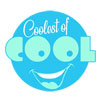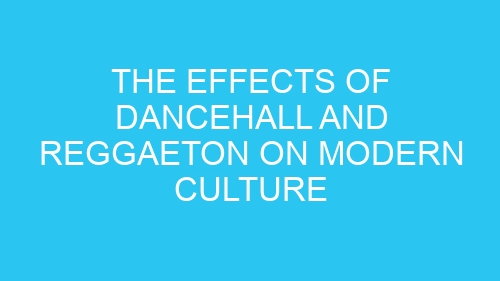-
Table of Contents
The Influence of Dancehall and Reggaeton Music on Fashion Trends
Dancehall and reggaeton music have undeniably made a significant impact on modern culture. From the infectious beats to the catchy lyrics, these genres have managed to infiltrate various aspects of our lives, including fashion trends. Yes, you heard it right – dancehall and reggaeton have influenced the way we dress, and it’s time to take a closer look at this fascinating phenomenon.
When it comes to fashion, dancehall and reggaeton artists are known for their bold and vibrant style. They are not afraid to experiment with colors, patterns, and accessories that make a statement. And let’s be honest, who doesn’t want to stand out in a crowd? These artists have shown us that fashion is not just about following trends but about expressing our individuality and embracing our unique style.
One of the most noticeable influences of dancehall and reggaeton on fashion is the rise of streetwear. The artists’ love for baggy pants, oversized t-shirts, and sneakers has seeped into mainstream fashion, making streetwear a staple in many people’s wardrobes. It’s all about comfort and attitude – the perfect combination for those who want to look effortlessly cool.
But it’s not just the clothing that has been influenced by dancehall and reggaeton; accessories have also taken a cue from these genres. From chunky gold chains to statement earrings, these artists have shown us that accessories can elevate any outfit and add that extra touch of swag. So, don’t be afraid to pile on the bling and let your accessories do the talking.
And let’s not forget about the hairstyles. Dancehall and reggaeton artists have always been trendsetters when it comes to hair. Whether it’s the iconic dreadlocks or the colorful braids, they have shown us that our hair can be a form of self-expression. So, go ahead and experiment with different hairstyles – after all, it’s just hair, and it can always grow back.
But the influence of dancehall and reggaeton on fashion doesn’t stop at the artists themselves. Music videos have played a significant role in shaping fashion trends. From the iconic outfits in Sean Paul’s “Get Busy” to the vibrant ensembles in Daddy Yankee’s “Gasolina,” these videos have given us a glimpse into a world where fashion knows no boundaries.
And let’s not forget the dance moves. Dancehall and reggaeton have introduced us to some of the most iconic dance moves, from the dutty wine to the perreo. These dances have become a part of the culture, and with them, the fashion that accompanies them. Baggy pants and sneakers are not just comfortable; they also allow for freedom of movement, making them the perfect attire for busting a move on the dance floor.
In conclusion, dancehall and reggaeton have had a profound influence on fashion trends. From streetwear to accessories, hairstyles to music videos, these genres have shown us that fashion is not just about following trends but about expressing our individuality and embracing our unique style. So, the next time you’re getting dressed, don’t be afraid to channel your inner dancehall or reggaeton artist and let your fashion choices speak volumes. After all, life is too short to blend in when you were born to stand out.
The Evolution of Dancehall and Reggaeton Dance Styles in Contemporary Culture
Dancehall and reggaeton, two vibrant and energetic music genres, have undeniably left their mark on modern culture. From the infectious beats to the provocative dance moves, these genres have evolved over time, captivating audiences worldwide. In this article, we will explore the evolution of dancehall and reggaeton dance styles in contemporary culture, taking a closer look at how they have influenced the way we move and groove.
Let’s start by diving into the roots of dancehall and reggaeton. Dancehall originated in Jamaica in the late 1970s, drawing inspiration from reggae music. It quickly gained popularity, with its infectious rhythms and catchy lyrics. Reggaeton, on the other hand, emerged in Puerto Rico in the 1990s, blending reggae, hip-hop, and Latin American music. Both genres share a common thread of vibrant beats and pulsating rhythms that make it impossible to resist tapping your feet.
As dancehall and reggaeton gained momentum, so did their accompanying dance styles. Dancehall dance moves are characterized by their high energy and expressive nature. From the iconic “daggering” to the “bogle,” these moves push the boundaries of what is considered socially acceptable. They are bold, daring, and often leave audiences in awe of the dancers’ agility and flexibility.
Reggaeton dance styles, on the other hand, are a fusion of various Latin American dance forms, such as salsa, merengue, and hip-hop. The moves are sensual, rhythmic, and exude confidence. From the sultry body rolls to the intricate footwork, reggaeton dancers effortlessly command attention with their smooth and fluid movements.
In recent years, dancehall and reggaeton dance styles have become a global phenomenon, transcending cultural boundaries. They have infiltrated music videos, dance competitions, and even fitness classes. The influence of these dance styles can be seen in popular culture, with artists like Rihanna and Beyoncé incorporating dancehall and reggaeton-inspired moves into their performances.
But what makes dancehall and reggaeton dance styles so appealing? Perhaps it’s the freedom they offer, allowing individuals to express themselves without inhibition. These dance styles encourage self-confidence, body positivity, and a celebration of individuality. They provide an outlet for people to let loose, forget their worries, and simply enjoy the music and movement.
Moreover, dancehall and reggaeton dance styles have also become a form of cultural expression. They serve as a platform for artists to showcase their heritage and pay homage to their roots. Through dance, individuals can connect with their cultural identity and share it with the world.
In conclusion, the evolution of dancehall and reggaeton dance styles in contemporary culture has had a profound impact on the way we move and groove. From their humble beginnings in Jamaica and Puerto Rico, these genres have grown to become global sensations. The infectious beats and provocative dance moves have captivated audiences worldwide, inspiring individuals to embrace their inner dancer. Dancehall and reggaeton dance styles offer a sense of freedom, self-expression, and cultural connection. So next time you hear those irresistible rhythms, don’t be afraid to let go and dance like nobody’s watching.
The Impact of Dancehall and Reggaeton on Language and Slang in Modern Society
Dancehall and reggaeton, two vibrant and energetic genres of music, have undeniably made their mark on modern culture. From the infectious beats to the catchy lyrics, these genres have captivated audiences around the world. But beyond the music itself, dancehall and reggaeton have also had a significant impact on language and slang in modern society. So, let’s dive into the fascinating world of dancehall and reggaeton and explore how they have shaped the way we speak today.
One cannot discuss dancehall and reggaeton without acknowledging their influence on language. These genres have introduced a plethora of new words and phrases into our everyday vocabulary. Whether it’s the Jamaican patois in dancehall or the Spanish slang in reggaeton, these genres have given birth to a whole new lexicon. And let me tell you, it’s lit!
Take dancehall, for example. The Jamaican patois used in dancehall music has seeped into mainstream culture, with phrases like “big up,” “irie,” and “batty boy” becoming part of our everyday conversations. It’s like a secret language that only the cool kids understand. So, if you want to impress your friends, just drop a few dancehall phrases into your next conversation, and watch their jaws drop!
But dancehall isn’t the only genre making waves in the language department. Reggaeton, with its infectious beats and catchy lyrics, has also left its mark on modern slang. From “perreo” (a style of dance) to “papi” (a term of endearment for a man), reggaeton has given us a whole new set of words to play with. So, next time you’re at a party, don’t be afraid to bust out your best perreo moves and call someone “papi” – it’s all part of the reggaeton experience!
Now, you might be wondering, why does this matter? Well, language is a powerful tool that reflects the culture and identity of a community. By incorporating dancehall and reggaeton slang into our everyday speech, we are embracing the diversity and richness of these genres. It’s like a linguistic dance party, where everyone is invited to join in and have a good time.
But it’s not just about the words themselves; it’s also about the attitude and swagger that comes with them. Dancehall and reggaeton have a certain flair that can’t be replicated. When you use their slang, you’re not just speaking words – you’re embodying a whole vibe. It’s like putting on a pair of sunglasses and instantly feeling cooler. So, if you want to add a little extra spice to your conversations, just sprinkle in some dancehall or reggaeton slang, and watch as heads turn in awe.
In conclusion, dancehall and reggaeton have had a profound impact on language and slang in modern society. From the Jamaican patois of dancehall to the Spanish slang of reggaeton, these genres have introduced a whole new lexicon into our everyday vocabulary. So, the next time you want to impress your friends or add a little extra flavor to your conversations, just tap into the world of dancehall and reggaeton. Trust me, it’s a linguistic adventure you won’t want to miss!

